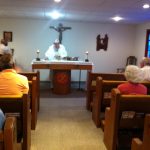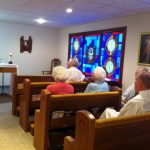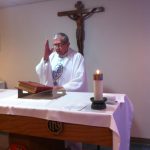Mundelein Seminary
1000 East Maple Avenue
Mundelein IL 60060
December 26, 2015
Feast of the Holy Family: Jesus, Mary, Joseph
Dear Stigmatine Lay Member,
With Christmas behind us, and New Year’s Day just ahead – it is good time – in this Year of Mercy – to reflect with St. Gaspar Bertoni, regarding the passing of time. In Italian, there is a word that sums up much of his life: Fugacità – Tempus fugit! How quickly time goes by! – these liturgical feasts and the Saints of the year all have their message for each one of us.
St. Gaspar once wrote [July 8, 1808]:
“Making the most of your time” (Ep 5, 16). Time never comes back. We have therefore to use it with great diligence.
In this note there are three separate parts that seem to be closely connected to a warning of the Imitation of Christ. [1] This is also in three parts:
… Keep always in your mind the end. The past time never comes back. You will never acquire virtue without care and diligence…
The year 2016 presents us [myself included!] with much grateful reflection: – on November 4, 2016 – the Stigmatine community celebrates 200 years of life! On a much lesser scale, my own life celebrates this new year in a special way: I joined the Stigmatines at Waltham on the Feast of the Epiphany, January 6, 1946 – 70 years ago! And on July 1, 1956, I was ordained a priest – so this new year will mark 60 years of Stigmatine priesthood for me. Please join me – through St. Gaspar’s inspiration – in thanking God for all that was, for what is now and for all we look forward to in hope.
Sometimes one thinks of the “good old days”! This may have some value, as to express thanks to God – and learn the necessary lessons for doing better from past mistakes. The world of the past is gone! And God chose us all before this world even began! [Ep 1:4]. The word “Ex-odus” gives us a challenging insight: in our return to God, we are all invited by vocation to leave what was, live what is, and strive for whatever God may want of us in the future. In the Our Father, we pray for the bread of this day – the Psalmist reminds us: this is the day the Lord has made, let us rejoice in it! [Ps 118:24].
Modern astronomy, with the considerable insights offered these last 25 years or more from the Hubble telescope, amazes us all especially about the number of the stars and planets – their distances – their speed – their age! Again a Psalmist tells us: that a thousand years in the sight of God are like an hour in the night! [Ps 89]. When we cannot sleep, that may seem like a long time – but when all is said and done, this, too, passes! A “Light Year’ is like 6 trillion miles! – and science has contacted distant objects, thousands upon thousands of light years away! In comparison to such a “light-year” a 75 year life – span is like the blink of the eye – a century has been measured as meaning about 6 seconds! It has been said that the sun has 10 billion years of life and has used up 5 of these – as St. Thomas said in another context, Christ entered history in the middle of the night and in the middle of time! [This has led to the “insiders’” joke: eat your desert first, life is uncertain!] But, with St. Gaspar, we firmly believe we are all in God’s hands.
Scripture often reminds us of this as modern theology and liturgy remind us:
THIS DAY: the spirit behind the Liturgy of the Hours is the blessing of the whole day: morning, noon, even-tide and night. In the General Instruction for the “Liturgy of the Hours” (February 2, 1971), it is stated:
“…: Christ told us about the need to pray continually and never lose heart (Lk 18:1). The Church has faithfully heeded this exhortation by never ceasing in her prayer and urging us to pray. Through Him, let us offer God an unending sacrifice of praise (Heb 13:15). The Church not only satisfies this precept by celebrating the Eucharist, but also in other different ways especially by celebrating the Liturgy of the Hours. Compared with other liturgical actions, the particular characteristic which ancient tradition has attended to the Liturgy of the Hours is that it should consecrate the course of the day and night (SC 83, 84).
As his spiritual diary drew towards its conclusion, St. Gaspar wrote the following on May 24, 1810: Today, therefore, if you shall hear His voice… harden not your hearts as those ones did, to whom He swore in His wrath… if they will enter into His rest…
The Three Masses of Christ offer an on-going contemplative theological reflection on the divine transcendence, and yet the impassibility of God – in these three aspects of the mystery of the Incarnation:-
- the presence of Jesus Christ as the Eternal World in his Eternal Birth, His ‘pre-existence’ [Jn 1:1];
- His Birth from Mary at Dawn, in the virginal of the Eternal Son – and the initial beginning of His Church;
- The on-going birth of Christ in the minds and hearts of the Faithful open through Divine Grace to His coming until the Second Advent. Here the Divine transcendence and imminence come into contact and almost inter-twine but ‘without confusion. In this On-going birth of Christ is the passing over of each of the Faithful from sin to life – believing in Him is an initial realized eschatology.
This is continued in a recent reading from the Liturgy of the Hours:
| [A sermon by St Bernard |
| Let the word of the Lord come to us] |
We know that the coming of the Lord is threefold: the third coming is between the other two and it is not visible in the way they are. At his first coming the Lord was seen on earth and lived among men, who saw him and hated him. At his last coming All flesh shall see the salvation of our God, and They shall look on him whom they have pierced. In the middle, the hidden coming, only the chosen see him, and they see him within themselves; and so their souls are saved. The first coming was in flesh and weakness, the middle coming is in spirit and power, and the final coming will be in glory and majesty.
Our late, illustrious Stigmatine confrere, Fr. Cornelio Fabro, CSS [+May 1995] developed the theme as the “contemporaneity” of Christ in our daily lives – which, he believed, pertained to our Founder to a great extent. There is a strong biblical background to this – as the Trinity dwells within [Jn 17:26] – Grace is a share in God’s nature [2 P 1:4] – the recurring themes: in Christ Jesus, in the Holy Spirit teach this lesson with simple eloquence. While we are indeed a “Resurrection People”, we also believe that in the reception of Holy Communion we receive the Lord as He is now, in His risen state. While Jesus can no longer suffer in His physical body, He daily does so in a mysterious manner, in His “mystical body’ the Church. He is with us, unto the consummation of this world.
For life’s journey – especially in the “dark places”, St. Gaspar was convinced that God’s Word is like a Light for our persevering journey [Ps 119:105]. May Mary, Star of the Sea – the Morning Star, guide us all on our life-long journey home to God.
Fraternally yours in the Merciful Lord,
Rev, Joseph Henchey, CSS
Acting Spiritual Moderator
[1] Book I, c. 25, 11.



